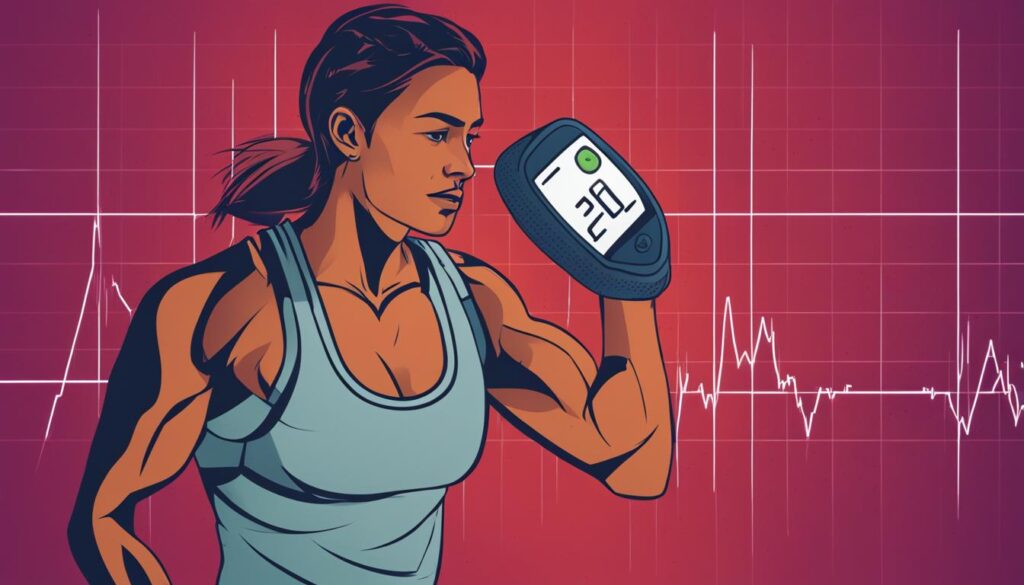When it comes to achieving your fat loss goals, heart rate focused workouts can be a game-changer. By understanding and working within your heart rate zones, you can maximize the effectiveness of your workouts and optimize fat burning. Whether you’re a beginner or an experienced fitness enthusiast, heart rate focused workouts can help you achieve the results you desire.
Heart rate zones are intensity levels of exercise that determine which fuel source your body uses during physical activity. There are five heart rate zones, each with its own benefits and challenges. Zone 1 is very light exercise, Zone 2 is light exercise, Zone 3 is moderate exercise, Zone 4 is hard/threshold exercise, and Zone 5 is maximal exercise. By tailoring your workouts to your target heart rate zone, you can optimize fat loss and make significant progress towards your weight loss goals.
Key Takeaways:
- Heart rate focused workouts can optimize fat loss by tailoring your exercise intensity to specific heart rate zones.
- Understanding your target heart rate zone is crucial for designing effective fat burning exercise routines.
- Working out in higher intensity heart rate zones can help burn more total calories, contributing to weight loss.
- Heart rate trackers, such as wearable devices or smartphone applications, can be helpful tools for monitoring and adjusting exercise intensity.
- A balanced diet, appropriate portion sizes, hydration, and sufficient sleep are essential factors for achieving fat loss.
Understanding Heart Rate Zones for Fat Loss
In order to optimize fat loss and achieve your fitness goals, it’s important to understand the concept of heart rate zones. Each heart rate zone represents a different intensity level of exercise, ranging from very light to maximal exercise.
- Zone 1: Very light exercise
- Zone 2: Light exercise
- Zone 3: Moderate exercise
- Zone 4: Hard/threshold exercise
- Zone 5: Maximal exercise
By working out within specific heart rate zones, you can effectively optimize fat loss. This is because each zone utilizes a different mix of fats and carbohydrates as fuel sources, and understanding which zone you are working in can help you tailor your workouts accordingly.
In order to determine which heart rate zone you are working in, it’s important to calculate your maximum heart rate. There are various methods to calculate maximum heart rate, but a simple formula is to subtract your age from 220. This will give you a rough estimate of your maximum heart rate and help you identify the appropriate heart rate zone for your workouts.
Example Calculation:
If you are 30 years old, your maximum heart rate would be approximately 190 beats per minute (220 – 30 = 190). By targeting around 70% of your maximum heart rate, you can aim for a fat burning heart rate zone of approximately 133 beats per minute.
Understanding and working within specific heart rate zones is a valuable tool for optimizing fat loss and achieving your fitness goals. By tailoring your workouts to the appropriate intensity level, you can maximize fat burn and make the most out of your exercise routine.
The Ideal Heart Rate Zone for Fat Loss
When it comes to fat loss, finding the ideal heart rate zone is key. While Zones 1 and 2 may burn more fat as a fuel source, they may not be the most effective zones for weight loss. The key to weight loss lies in the number of calories burned, and higher intensity exercises in Zones 4 and 5 can help maximize calorie expenditure overall.
It’s important to strike a balance between different heart rate zones in order to optimize fat burn and achieve your weight loss goals. Incorporating targeted workouts that focus on heart rate can help you reach your desired fat loss results.
Maximizing Fat Burn and Weight Loss
While exercising in lower heart rate zones may predominantly use fat as a fuel source, it’s important to consider the overall calorie burn. Higher intensity exercises in Zones 4 and 5 burn more total calories and can contribute to greater weight loss.
By incorporating heart rate targeted workouts that involve higher intensity exercises, such as interval training or circuit training, you can maximize both fat burn and calorie burn. These types of workouts challenge your body and stimulate metabolism, leading to increased fat loss when combined with a calorie deficit.
“Higher intensity exercises in heart rate Zones 4 and 5 can help burn more calories overall, leading to greater weight loss.”
However, it’s important to note that everyone’s ideal heart rate zone for fat loss may vary. Factors such as fitness level, personal preferences, and underlying health conditions should be taken into consideration when determining the ideal heart rate zone for your workouts.
Customizing Your Workouts
To ensure you are working within your ideal heart rate zone for fat loss, it’s recommended to use a heart rate monitor or wearable device. These devices provide real-time feedback on your heart rate, allowing you to adjust your workout intensity accordingly.
Incorporating a variety of exercises that target different heart rate zones can also be beneficial. Combining lower intensity exercises, like brisk walking or jogging, with higher intensity exercises, such as sprints or jumping jacks, can help you achieve a well-rounded workout that maximizes both fat burn and calorie burn.
Calculating Your Target Heart Rate

To optimize your fat-burning workouts, it’s crucial to calculate your target heart rate. This helps you determine the intensity level at which you should be exercising for maximum effectiveness. To begin, you’ll need to know your maximum heart rate.
The simplest method for calculating your maximum heart rate is to subtract your age from 220. For example, if you are 30 years old, your maximum heart rate would be 190 beats per minute (220 – 30 = 190).
Once you have determined your maximum heart rate, you can then calculate your target heart rate for fat burning. This is typically around 70% of your maximum heart rate. Using the previous example, your target heart rate for fat burning would be around 133 beats per minute (190 x 0.7 = 133).
It’s important to note that these calculations are estimations and may vary depending on individual factors such as fitness level and overall health. It’s always a good idea to consult with a healthcare professional or a certified fitness trainer for personalized guidance.
| Age | Maximum Heart Rate (BPM) | Target Heart Rate for Fat Burning (70% of Maximum) (BPM) |
|---|---|---|
| 20 | 200 | 140 |
| 30 | 190 | 133 |
| 40 | 180 | 126 |
| 50 | 170 | 119 |
| 60 | 160 | 112 |
Using Heart Rate Trackers for Effective Workouts
Heart rate trackers, such as wearable devices or smartphone applications, are invaluable tools for enhancing your workouts and achieving optimal results. These devices provide real-time tracking of your heart rate, allowing you to monitor your intensity and ensure that you are working within the appropriate heart rate zone. By using a heart rate tracker, you can tailor your exercise intensity to maximize your fat-burning potential and improve your overall fitness.
One of the key advantages of heart rate trackers is their ability to provide real-time data during your workouts. This allows you to make immediate adjustments to your exercise intensity, ensuring that you are targeting the desired heart rate zone for optimal fat burning. Additionally, heart rate trackers can help you stay motivated and engaged with your workout routine by providing feedback on your progress and achievements.
Heart rate trackers come in various forms, including wristband monitors and chest strap monitors. The choice of device depends on personal preference and comfort. Wristband monitors are convenient and user-friendly, while chest strap monitors provide more accurate heart rate measurements. Consider your needs and preferences when selecting a heart rate tracker to ensure it aligns with your fitness goals and lifestyle.
“Using a heart rate tracker has been a game-changer for my workouts. It helps me maintain the right intensity, pushes me to new limits, and keeps me motivated to achieve my fitness goals.” – Sarah Adams
Heart rate trackers are widely available, with many reputable brands offering a diverse range of options. Some popular heart rate tracker brands include Fitbit, Garmin, Polar, and Apple Watch. Before purchasing a heart rate tracker, research different models to find the one that best suits your needs and budget. Consider factors such as features, reliability, and user reviews to make an informed decision.
The Benefits of Using a Heart Rate Tracker
Using a heart rate tracker during your workouts offers several benefits:
- Accurate Tracking: Heart rate trackers provide real-time heart rate data, enabling you to monitor and optimize your exercise intensity.
- Motivation and Accountability: By tracking your progress and achievements, heart rate trackers keep you motivated and accountable to your fitness goals.
- Optimized Fat Burning: Working within the appropriate heart rate zone can maximize fat burning and improve overall fitness.
- Workout Variety: Heart rate trackers allow you to experiment with different workout intensities and adjust your routine based on your goals and preferences.
- Personalization: By tracking your heart rate, you can tailor your workouts to your individual fitness level and optimize results.
Integrating a heart rate tracker into your fitness routine can provide valuable insights and help you make data-driven decisions about your workouts. Whether you are a beginner or an experienced fitness enthusiast, using a heart rate tracker can enhance your exercise experience and contribute to achieving your fitness goals.
The Key Rule for Losing Body Fat

The key rule for losing body fat is to create a calorie deficit, meaning you need to consume fewer calories than you burn. This can be achieved through a balanced diet and regular exercise. Different diets work for different people, so it’s important to find a diet that you can sustain and be consistent with.
Along with exercise, focusing on whole foods, watching portion sizes, staying hydrated, and getting enough sleep can also contribute to fat loss.
When it comes to losing body fat, the most important aspect is creating a calorie deficit. This means that the number of calories you consume should be less than the number of calories you burn through physical activity and normal bodily functions.
Achieving a calorie deficit is possible through a combination of diet and exercise. A weight loss diet should focus on consuming nutritious whole foods while limiting processed and high-calorie foods. It’s crucial to find a diet that suits your lifestyle and preferences, as this will increase the chances of long-term adherence.
In addition to following a weight loss diet, regular exercise is essential for burning calories and promoting fat loss. Incorporating a mix of cardiovascular exercises, strength training, and flexibility exercises can help optimize weight loss and improve overall health.
“Creating a calorie deficit through a balanced diet and regular exercise is the foundation of any successful weight loss journey. It’s important to understand that there is no one-size-fits-all approach to losing body fat. Find a diet that works for you, prioritize whole foods, and stay consistent with your exercise routine to achieve sustainable results.”
By focusing on a well-rounded weight loss plan that includes a calorie deficit, a nutritious diet, and regular exercise, you can achieve your fat loss goals and improve your overall health and well-being.
Varying Intensity for Effective Fat Burn

Varying the intensity of your workouts is crucial for effective fat burn. While low-intensity workouts, such as steady-state cardio, are great for building endurance, higher intensity workouts, such as high-intensity interval training (HIIT), can help burn more calories in a shorter amount of time.
HIIT involves alternating periods of high-intensity exercise with periods of lower intensity or rest. This type of workout not only boosts fat burning but also improves cardiovascular fitness.
“By incorporating high-intensity intervals into your training routine, you can challenge your body to work harder and burn more calories, leading to greater fat loss,” says Dr. Jane Sullivan, a fitness expert.
The Science Behind HIIT
HIIT is a powerful fat-burning tool because it engages both aerobic and anaerobic systems in your body. During high-intensity intervals, your body utilizes a greater amount of stored carbohydrates for energy. This depletes glycogen stores, and during the lower intensity or rest periods, your body shifts to using stored fat as the primary fuel source.
This metabolic shift, known as excess post-exercise oxygen consumption (EPOC) or the “afterburn effect,” can lead to an increased calorie burn even after you’ve finished your workout. HIIT workouts have been shown to elevate your metabolism for up to 24 hours post-exercise, helping you burn more fat throughout the day.
The Benefits of Varying Intensity
Incorporating varying intensity into your workouts offers numerous benefits for fat burning and overall fitness:
- Increased calorie burn: High-intensity intervals require more energy, resulting in higher calorie expenditure during and after your workout.
- Improved cardiovascular fitness: HIIT workouts challenge your heart and lungs, leading to increased cardiovascular endurance.
- Muscle preservation: By challenging your muscles with high-intensity intervals, you can help maintain muscle mass while burning fat.
- Time efficiency: HIIT workouts are typically shorter in duration but yield significant results in terms of fat burning and fitness improvement.
| Exercise Type | Duration | Intensity | Example |
|---|---|---|---|
| Warm-up | 5 minutes | Low | Brisk walking |
| High-intensity interval | 30 seconds | High | Sprinting |
| Rest interval | 90 seconds | Low | Walking |
| Repeat | 8-10 cycles | Alternating | – |
| Cool-down | 5 minutes | Low | Slow jogging |
Remember to always start with a proper warm-up and cool-down to prevent injury and allow your body to gradually adjust to the workout intensity.
Choosing Fat-Burning Workouts

When it comes to maximizing fat burn, incorporating a variety of cardiovascular exercises is key. These workouts elevate your heart rate and help you reach your fat-burning heart rate zone. Some effective cardio exercises for fat loss include:
- Slow jogging
- Brisk walking
- Water aerobics
- Cycling at a lower speed
- Tennis (doubles)
- Ballroom dancing
By engaging in these activities, you can maintain a moderate level of activity that elevates your heart rate while still allowing you to carry on a conversation. It’s important to find exercises that you enjoy and can sustain over time.
Why Interval Training Matters
In addition to traditional cardio exercises, incorporating interval training can be highly beneficial for fat burn. Interval training involves alternating between high-intensity exercises and low-intensity or rest periods. This type of workout not only challenges your cardiovascular system but also boosts calorie burn even after your workout is complete.
Interval training is a powerful tool for fat loss. It allows you to push your limits during the hard intervals and recover during the rest periods. The combination of high and low-intensity exercises keeps your body guessing and maximizes fat burn.
By incorporating interval training and alternating between different levels of intensity, you can optimize your fat-burning potential and enhance overall calorie expenditure.
Remember, when choosing fat-burning workouts, it’s important to listen to your body and gradually increase the intensity and duration of your workouts. Consult with a fitness professional if you have any concerns or specific fitness goals.
Other Factors for Fat Loss

While exercise is crucial for fat loss and weight management, there are other factors that also play a significant role in achieving your weight loss goals. Adopting a balanced diet that focuses on whole foods, practicing healthy eating habits, and incorporating certain lifestyle practices can enhance your fat-burning journey.
Fuel Your Body with a Balanced Diet
Eating a well-rounded, balanced diet is essential when it comes to shedding excess body fat. Include a variety of nutrient-dense whole foods such as fruits, vegetables, lean proteins, whole grains, and healthy fats in your meals. These foods provide essential vitamins, minerals, and antioxidants that support a healthy metabolism and promote fat loss.
Watch Your Portion Sizes
Being mindful of your portion sizes can help control calorie intake and contribute to weight loss. Opt for smaller plates and bowls to visually control the amount of food you consume. Pay attention to hunger and fullness cues to avoid overeating and maintain a balanced calorie intake.
Stay Hydrated
Drinking an adequate amount of water throughout the day is essential for overall health and weight management. Staying hydrated helps support your metabolism, aids digestion, and can help curb cravings. Aim to drink at least eight glasses of water per day, or more if you are physically active or live in a hot climate.
Get Enough Sleep
Sleep plays a crucial role in maintaining a healthy weight. Lack of sleep can disrupt hormones involved in appetite regulation and increase cravings, leading to weight gain. Aim for at least seven to eight hours of quality sleep each night to support your weight loss efforts.
Remember, achieving a healthy weight involves a combination of various lifestyle factors. By adopting a balanced diet, practicing portion control, staying hydrated, and getting adequate sleep, you’ll create a solid foundation for successful fat loss.
Consulting with a healthcare professional, such as a doctor or registered dietitian, can provide personalized guidance and support tailored to your specific needs and goals. They can help you create a sustainable plan that prioritizes your health while effectively promoting fat loss.
The Truth about the Fat-Burning Zone

The fat-burning zone has long been touted as the ideal intensity level for burning fat during workouts. It refers to the zone where your body primarily relies on fat as a fuel source. Many people believe that exercising in this zone will lead to more significant fat loss.
However, it’s important to understand that the fat-burning zone does not guarantee that you will burn more fat compared to working out at higher intensities. While lower-intensity workouts, such as light jogging or brisk walking, do burn a higher percentage of calories from fat, they may not lead to higher total fat burn.
The key to weight loss is creating a calorie deficit, which means burning more calories than you consume. To achieve this, you need to consider not only the percentage of calories burned from fat but also the total calories burned during your workout.
In fact, higher intensity workouts, such as interval training or high-intensity cardio exercises, can result in burning more total calories. These workouts elevate your heart rate and increase your overall calorie expenditure, potentially leading to greater fat loss in the long run.
While lower-intensity workouts have their place and can help improve your endurance, it’s essential to incorporate higher intensity exercises into your routine to maximize fat burn and overall calorie expenditure.
Benefits of Higher Intensity Workouts
- Increased calorie burn: High-intensity workouts can burn more calories in a shorter amount of time, leading to a greater calorie deficit.
- Improved cardiovascular fitness: Intense exercises challenge your cardiovascular system, helping to improve endurance and overall fitness.
- Elevated metabolism: High-intensity workouts can increase your metabolism, leading to continued calorie burn even after your workout is complete.
- Time-efficient: With higher intensity workouts, you can achieve the same or greater results in less time compared to lower intensity exercises.
While incorporating higher intensity workouts into your routine, it’s important to listen to your body and find a balance that works for you. If you’re new to exercise or have any health concerns, consult with a healthcare professional or a qualified fitness trainer before starting a new workout program.
Remember, the fat-burning zone is just one piece of the puzzle when it comes to achieving your weight loss goals. Balancing your workout intensity, creating a calorie deficit through a balanced diet, and adopting healthy lifestyle habits are equally important factors in your overall fat loss journey.
How Do Heart Rate Focused Workouts Compare to Morning Cardio Routines for Fat Loss?
Heart rate focused workouts and morning cardio routines both offer effective ways to burn fat. However, quicker fat burning routines are often associated with heart rate focused workouts due to their ability to elevate the heart rate and keep it in the fat-burning zone for an extended period of time.
Monitoring Heart Rate for Effective Workouts

Monitoring your heart rate during exercise is essential for maximizing the effectiveness of your workouts and achieving your fitness goals. By measuring your heart rate, you can accurately determine the intensity of your exercise and ensure that you’re working within the appropriate heart rate zone for optimal results.
One of the most common and convenient ways to monitor heart rate is by using heart rate monitors. These devices come in various forms, such as chest straps and wristbands, and provide continuous and accurate heart rate measurements.
The ability to track your heart rate in real-time allows you to make adjustments to your exercise intensity as needed. For example, if your heart rate is too low, you can increase the intensity to reach the target heart rate zone. Conversely, if your heart rate is too high, you can decrease the intensity to avoid overexertion.
Choosing the right heart rate monitoring device is crucial to ensure accurate measurements and a comfortable fit. Some individuals prefer chest straps for their precision, while others opt for wristbands for convenience and ease of use.
When selecting a heart rate monitor, consider the features that are important to you. For example, you may prefer a device that offers Bluetooth connectivity for seamless integration with fitness apps or a waterproof design for swimming or other water-based activities.
Overall, monitoring your heart rate during exercise provides valuable insights into the effectiveness of your workouts and helps you make informed decisions about your fitness regimen. By staying within the appropriate heart rate zone, you can optimize your training and achieve the desired results.
The Benefits of Heart Rate Monitoring
Incorporating heart rate monitoring into your fitness routine offers several benefits:
- Accurate intensity measurement: Heart rate monitors provide real-time data, allowing you to accurately measure and adjust the intensity of your workouts.
- Efficient calorie burn: By working within the appropriate heart rate zone, you can optimize calorie expenditure and maximize fat burning.
- Goal tracking: Tracking your heart rate over time can help you monitor progress, set realistic goals, and make adjustments to your fitness routine as necessary.
- Preventing overexertion: Monitoring your heart rate helps prevent overexertion and reduces the risk of injury during workouts.
| Heart Rate Zone | Target Heart Rate Range | Benefits |
|---|---|---|
| Zone 1: Very Light Exercise | 50-60% of maximum heart rate | – / Low-intensity recovery |
| Zone 2: Light Exercise | 60-70% of maximum heart rate | Improve cardiovascular fitness |
| Zone 3: Moderate Exercise | 70-80% of maximum heart rate | Build endurance and burn fat |
| Zone 4: Hard/Threshold Exercise | 80-90% of maximum heart rate | Improve anaerobic fitness and performance |
| Zone 5: Maximal Exercise | 90-100% of maximum heart rate | High-intensity interval training and maximum effort |
Using a heart rate monitor provides you with valuable data that can guide and enhance your workouts. By monitoring your heart rate and staying within the appropriate zones, you can optimize your exercise routine and achieve your fitness goals effectively.
Conclusion
Heart rate focused workouts offer an effective strategy for optimizing fat loss and achieving your weight loss goals. By understanding your heart rate zones and working within the appropriate intensity levels, you can maximize the effectiveness of your workouts. Varying your workout intensity with a combination of high and low-intensity exercises is key to effective fat burning.
Monitoring your heart rate during workouts is crucial for ensuring you are working within the targeted heart rate zone. Utilizing heart rate monitors, whether it’s a chest strap or a wristband, helps you track your heart rate in real-time, enabling you to make necessary adjustments to your exercise intensity.
However, it’s important to remember that heart rate focused workouts alone are not sufficient for successful weight loss. To achieve optimal results, it is essential to create a calorie deficit through a balanced diet and maintain healthy lifestyle habits. Incorporating a variety of cardiovascular exercises, watching portion sizes, and staying hydrated, are equally important strategies for effective fat loss.
Source Links
- https://www.cosmopolitan.com/uk/body/fitness-workouts/a28395035/heart-rate-zones-fat-burning/
- https://www.verywellfit.com/the-truth-about-the-fat-burning-zone-1231545
- https://www.healthline.com/health/fitness-exercise/fat-burning-heart-rate




